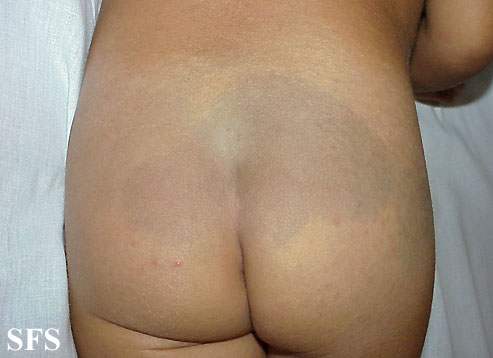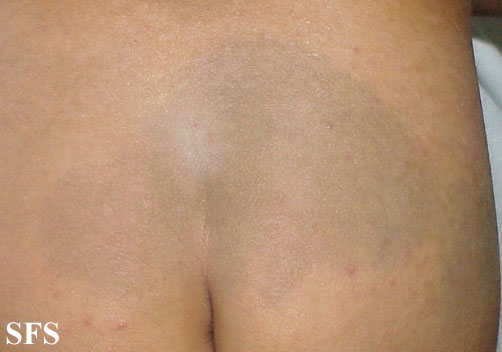Mongolian spot
 From Wikidoc - Reading time: 3 min
From Wikidoc - Reading time: 3 min
|
WikiDoc Resources for Mongolian spot |
|
Articles |
|---|
|
Most recent articles on Mongolian spot Most cited articles on Mongolian spot |
|
Media |
|
Powerpoint slides on Mongolian spot |
|
Evidence Based Medicine |
|
Clinical Trials |
|
Ongoing Trials on Mongolian spot at Clinical Trials.gov Trial results on Mongolian spot Clinical Trials on Mongolian spot at Google
|
|
Guidelines / Policies / Govt |
|
US National Guidelines Clearinghouse on Mongolian spot NICE Guidance on Mongolian spot
|
|
Books |
|
News |
|
Commentary |
|
Definitions |
|
Patient Resources / Community |
|
Patient resources on Mongolian spot Discussion groups on Mongolian spot Patient Handouts on Mongolian spot Directions to Hospitals Treating Mongolian spot Risk calculators and risk factors for Mongolian spot
|
|
Healthcare Provider Resources |
|
Causes & Risk Factors for Mongolian spot |
|
Continuing Medical Education (CME) |
|
International |
|
|
|
Business |
|
Experimental / Informatics |
Editor-In-Chief: C. Michael Gibson, M.S., M.D. [1]; Associate Editor(s)-in-Chief: Jesus Rosario Hernandez, M.D. [2].
Synonyms and keywords:: Mongolian blue spot.
Overview[edit | edit source]
A Mongolian Spot or Mongolian Blue Spot is a benign flat congenital birthmark with wavy borders and irregular shape, most common among people of East Asian descent, and named after Mongolians. It is also extremely prevalent among East Africans and Native Americans.[1][2] It normally vanishes three to five years after birth and almost always by puberty.
Origin[edit | edit source]
The Mongolian spot is a congenital developmental condition exclusively involving the skin. The blue colour is caused by melanocytes, melanin-containing cells, that are deep under the skin.[2] Usually, as multiple spots or one large patch, it covers one or more of the lumbosacral area (lower back), the buttocks, flanks, and shoulders.[2] It results from the entrapment of melanocytes in the dermis during their migration from the neural crest to the epidermis during embryonic development.[2]
The condition is not linked to sex; and male and female infants are equally predisposed to Mongolian spot. The spots are harmless.[2]
Among those who are not aware of the background of the Mongolian spots, it may sometimes be mistaken for a bruise.[3]
Prevalance[edit | edit source]
Mongolian spot is most prevalent among Mongols and other Asian groups, such as the Chinese, Koreans, Japanese, Vietnamese, etc. Nearly all East Asian infants are born with one or more Mongolian spot. The incidence of Mongolian spot among East Asian infants is 95-100%.[1] It is also common if only one of the parents is East Asian.
Among East African infants it is found at rates between 90-95%, and 85-90% of Native American infants.[1]
The incidence among Caucasians, that is, the indigenous peoples of Europe, the Middle East, North Africa and the Indian subcontinent (Pakistan, India, Bangladesh, Sri Lanka) is between 1-10%.[1]
Additionally, there is an incidence of 50-70% among Hispanics,[1] presumably as a result of the Native American admixture found in mestizos (people of mixed European and Native American ancestry) who comprise the largest racial group among Hispanics.
Physical examination[edit | edit source]
Gallery[edit | edit source]
Trunk[edit | edit source]
References[edit | edit source]
- ↑ 1.0 1.1 1.2 1.3 1.4 About Mongolian Spot
- ↑ 2.0 2.1 2.2 2.3 2.4 Mongolian blue spots - Health care guide discussing the Mongolian blue spot.
- ↑ Mongolian Spot - English information of Mongolian spot, written by Hironao NUMABE, M.D., Tokyo Medical University.
 KSF
KSF
